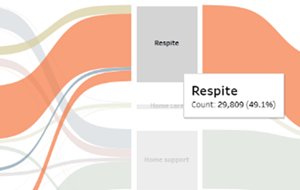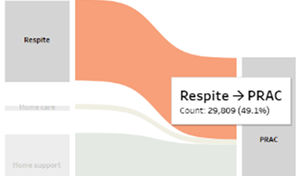Aged care needs are diverse and change over time. The aged care system in Australia offers a range of different services to meet individuals’ diverse and changing needs. It can be helpful to look at all the types of aged care an individual uses during their lifetime, to see if there are patterns in care use for particular groups of people (e.g. those aged 85+) or leading up to particular types of care (e.g. permanent residential aged care).
Last updated: 26 April 2023
Overview of pathways in aged care
The AIHW has created a link map, named Pathways in Aged Care (PIAC), that allows us to connect multiple types and instances of care for an individual over time. The latest linkage includes data on aged care assessments, use of aged care services and deaths for more than four million individuals, for dates from 1 July 1997 to 30 June 2020. You can learn more about PIAC in our Technical Document.
From analysing PIAC data we can see that:
- Aged care pathways are not always linear – people can go back and forth between different types of aged care and may use multiple types of care at the same time
- Pathways are complex – it’s important to also consider how long people use different types of care and how long they wait to access care
- Changes in aged care policy and provision can drive some changes in aged care use
Over time we will use PIAC data to explore aspects of the above three points in more detail and links to the findings will be available on this page.
Pathways to permanent residential care
Our first investigations have been of the types of care people use in the lead up to entering permanent residential aged care (PRAC), as shown in the Sankey visualisation below.
Understanding the pathways analysis
The PIAC link map allows us to connect an individual's aged care journey as a "pathway", but there are limitations to this type of analysis. It is important to understand that:
- Pathways put the events in chronological order based on when they started. This means that the most recently used care type might not be last in the pathway to PRAC, because it might have started before another care type. For example, a person who accesses home support before and after a residential respite stay may present as a respite-to-permanent-residential-care admission.
- Consecutive use of the same care type has been condensed into one event. For example, five separate episodes of respite residential care with no use of an alternative care type during this period are displayed as one respite event.
- Concurrent use of aged care services and breaks in care use are not considered.
- Care types outside the scope of PIAC, such as hospitalisations or informal care arrangements, are not included in the pathways, even though they have the potential to play significant roles in an individual’s aged care journey. For example, one person may proceed straight from respite residential care to permanent residential care, while another may have a month of informal care between respite and permanent residential care admission, but these differences would not be represented.
- Differences over time may reflect changes in data availability or maturity, or policy changes to care type eligibility, rather than changes in service use. Comparisons over years should therefore be made with caution.
Reading the Sankey
The Sankey provides a visual representation of pathways to permanent residential aged care admission. It is helpful to know that:
- The population of interest (people who entered permanent residential aged care for the first time in their life) are represented on the far right of the dashboard (“PRAC” box). This represents the end of the pathway in this analysis.
- The use of aged care services prior to permanent residential care is represented in three columns, with the ‘second-last’ being the care type immediately preceding the first permanent residential aged care admission, the ‘third-last’ being the care type immediately preceding the second-last care type, and so on. Each care type is represented by a separate box (node) in each column. The height of each node is proportional to the number of people using that care type before entering PRAC (or before the second- or third-last steps).
- Only the last three steps of the pathway before entering permanent residential care are shown. This covers the care service use for the majority of people entering permanent residential care for the first time (at least 70% each year), but some people would have longer pathways than represented here.
- ‘No aged care’ nodes are used to represent the start of the pathway, meaning these people had not previously used any of the aged care types within the scope of PIAC.
- Connecting lines represent the flow of people between service types. The width of the lines is proportional to the number of people moving from one service type to the next.
- The year slider filter is available at the bottom right of the dashboard to filter the PRAC admissions by financial year. Care types in the ‘second-last’, ‘third-last’ and ‘fourth-last’ columns could be from any financial year e.g. people in the second-last column may have used that care type one year before or 10 years before entering permanent residential aged care. In addition, even though care types in the ‘second-last’, ‘third-last’ and fourth-last’ columns have the same horizontal size, they may represent very different durations of care use.
- Hover functions over the nodes and connecting lines allow for further data exploration, including the percentage of care recipients coming from each of the previous care types.
- Hover over the node to display the number of people using the care type in that node.
- Hover on a connecting line to the left of the node to display the number of people moving from one care type to the next, and the proportion of people coming from previous care types.
 |
 |
|||
| 29,809 people used respite residential care preceding first entry to permanent residential care in 2019–20. | 49.1% of people entering permanent residential care in 2019–20 had previously used respite residential care. |
For people entering permanent residential aged care for the first time:
- In 2019–20 the highest proportion came from respite residential care (49.1%), followed by home support (38.4%), and no prior use of aged care (5.5%).
- This was different to the pattern in 2014–15 when people most commonly entered from home support (43.9%), followed by respite residential care (39.0%) and transition care (7.5%).
- The proportion of people who had not used any other care types before entry decreased over time from 8.6% in 2010–11 to 5.5% in 2019–20.
- The proportion of people coming from respite residential care increased over time from 32.5% in 2010–11 to 49.1% in 2019–20.
First admissions to permanent residential care
In 2019–20, there were almost 61,000 first admissions to permanent residential care. Of the people admitted:
- 36,000 (58.7%) were female
- 33,000 (53.6%) were aged 85 years and over
- 1,300 (2.1%) identified as Aboriginal and/or Torres Strait Islander
The characteristics of people entering care should be interpreted in the context of population trends. When compared to the target population for aged care (all people aged 70 and over), the number of females and males entering permanent residential care for the first time has decreased since 2010–11. This may in part reflect increasing availability and utilisation of other types of aged care over that time period, particularly care in the home.
The table above demonstrates the top five pathways to permanent residential care first admission over 10 years from 2010–11 to 2019–20.
For first admissions to permanent residential care in 2019–20:
- More than 9 in 10 (94%) people had used another different aged care service anytime in their life before their first admission into permanent residential aged care.
- 63.6% had one or more respite episodes recorded
- 86.4% had an aged care package and/or home and community care episode recorded
- 16.3% had one or more episodes of transition care/short term restorative care recorded
- There were 1,761 unique pathways to permanent residential aged care first admission. The most common pathway to permanent residential care was home support > respite residential care > permanent residential care (18.1%), followed by home support > permanent residential care (17.9%), and respite residential care > permanent residential care (6.8%).
Publications and data
-
Timeliness of access to aged care services in Australia
-
Exploring how transitional aged care supports older people leaving hospital
-
Pathways in Aged Care 2020: Technical guide
-
Exploring pathways for younger people living in residential aged care
-
Pathways of younger people entering permanent residential aged care

